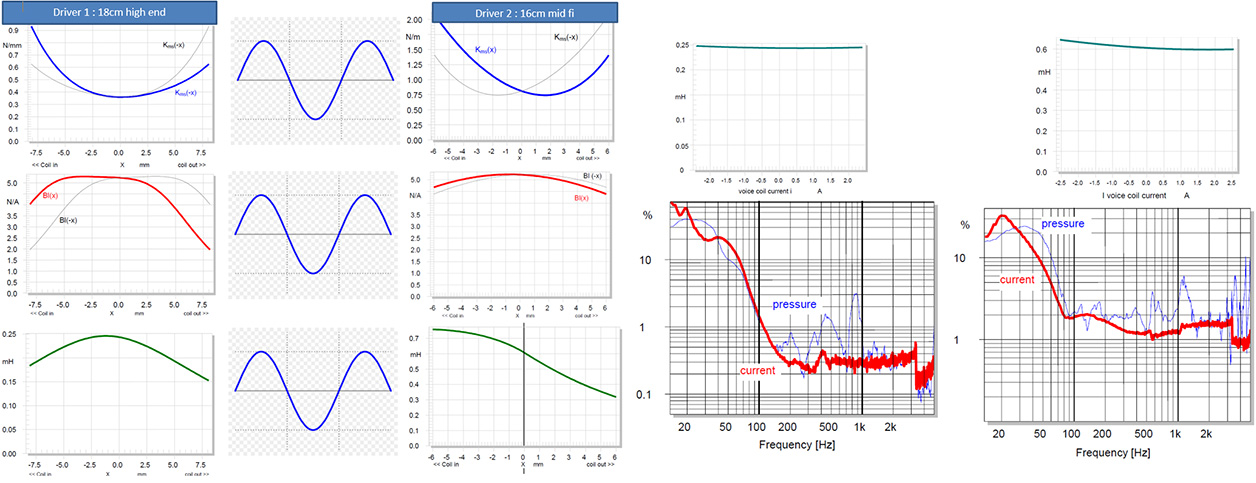"Now we have explained the major types of distortion which traditional dynamic drivers suffer as a function of their basic construction. You might shrug your shoulders and think that all this is just like jitter where engineers chase a few silly pico seconds. You might assume that all of this is no different from THD where amplifiers chase after 0.0005% figures. Sadly the next graphs show clearly how by far the largest distortion of any hifi system always comes from its drive units.
"The numbers here are typical, i.e. 10-30% distortion at nominal excursion. We show examples of all types of distortion. The one with the thick black line shows how they sum. Below 100Hz, distortion easily hits 10-30%, above 100Hz it lowers to about 1-2%. But remember that this is always measured with steady-state test tones. If you play music signal, the distortion of a 40Hz tone will affect a 200Hz tone above it by the same amount. So the graph may show 1% at 400Hz but this could increase if bass tones occur simultaneously as they do with music. The combined graph further shows that the black line almost runs on top of the blue KMS line which reflects the distortion of the suspension. This means that the suspension is responsible for most of the distortion of today's drivers. This is how Dr. Klippel arrived at his conclusion. This is why we endeavored to eliminate these primary sources of distortion in our loudspeaker drive unit."

Having read how Ilumnia eliminate or reduce common forms of dynamic compression, AM and IMD distortion and related nonlinearities—all of which overlay to occur simultaneously and interactively—what do you expect hearing them removed sounds like? Cleaner as in, more detailed and transparent? Faster as in, energetically less reticent and dull? Dynamically turbo-charged? Brighter? What? Time to send that post card.
 The cliff notes. The first thing I tagged because it was so potent—and entirely unexpected as already explained—was the fulsome saturated tonality. It played opposition to lean haggardness from appetite-killing excessive caffeine. This tonal expander action tracked down into low SPL. It opposed typical tendencies to go lean, pale and inject ever more white as playback volumes reduce. This behavior cancelled byproducts associated with maximum speed. To go faster, one normally casts off ever greater mass. One wants to become optimally light and ultra responsive. Instead, Ilumnia's claimed distortion reduction manifested in more developed tome to be heavier. That was the first gotcha moment.
The cliff notes. The first thing I tagged because it was so potent—and entirely unexpected as already explained—was the fulsome saturated tonality. It played opposition to lean haggardness from appetite-killing excessive caffeine. This tonal expander action tracked down into low SPL. It opposed typical tendencies to go lean, pale and inject ever more white as playback volumes reduce. This behavior cancelled byproducts associated with maximum speed. To go faster, one normally casts off ever greater mass. One wants to become optimally light and ultra responsive. Instead, Ilumnia's claimed distortion reduction manifested in more developed tome to be heavier. That was the first gotcha moment.
Next was the imaging. Because you can listen to the stalkers solo—just turn off power to the 40Hz-7kHz widebanders—it's easy to hear how low they tweet. They come in at 3.5kHz 2nd order, "lower than Magister due to lower sensitivity as a consequence of physical limitations of monitors." It explains why stereophonic imaging remained more specific. The bullet tweeters embed enough directionality cues sufficiently low in frequency to avoid those common more diffusive omni tendencies. But since Vocalis does propagate 360° across its main driver, it also imaged utterly out of the box to become about maximally wide panoramic vista with normal not soft or hyper focus.
As Franck Tchang already exploited in his dispersion-lens up/downfiring 5" widebanders of the César and Philharmonic omnis under his Avantages Audio brand, running widebanders 360° combats their innate beaming. Where a 10" Zu widebander gets progressively beamier as it works up to its 10kHz end point, Ilumnia's 8" sidesteps that otherwise inevitable aperture narrowing and its associated side effects. While your ceiling will see narrower dispersion, your ears will not.
On an ambient Bombay Dub Orchestra track, I finally was shocked by how powerful and low sudden bass attacks hit from a stand-mount if big monitor. This was my first practical lesson in how significant reduction in common woofer distortion plus absence of usual dynamic compression could manifest. When a cabinet resists flexing to not contribute its own wooliness aka box talk—here a stacked Ply build with copious internal bracing is exceptionally inert—bass power can be truly exceptional. To exploit that beyond the appropriate limits for our smaller upstairs room, the show simply had to move downstairs.
But to first sign my postcard of initial impressions, on tone density and bass power/reach, Vocalis behaved like a robust floorstander of unusual chunkiness driven from warm electronics. On whisper-level persuasiveness, it acted like a high-sensitivity design. On image focus it played direct radiator. On out-of-the-box image spread, it was a true omni. As Germans would say, ein bunter Hund (a colorful dog aka mutt) to combine qualities of different breeds as Marja & Henk had written.